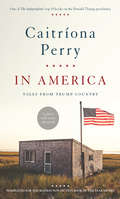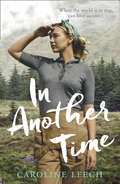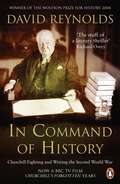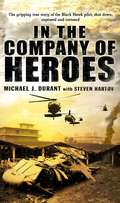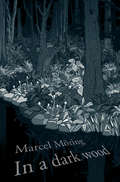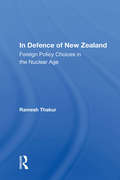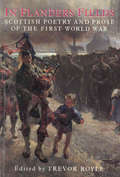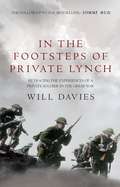- Table View
- List View
In a Time of Total War: The Federal Judiciary and the National Defense - 1940-1954 (Justice, International Law and Global Security)
by Joshua E. Kastenberg Eric MerriamThis book is a judicial, military and political history of the period 1941 to 1954. As such, it is also a United States legal history of both World War II and the early Cold War. Civil liberties, mass conscription, expanded military jurisdiction, property rights, labor relations, and war crimes arising from the conflict were all issues to come before the federal judiciary during this period and well beyond since the Supreme Court and the lower courts heard appeals from the government’s wartime decisions well into the 1970s. A detailed study of the judiciary during World War II evidences that while the majority of the justices and judges determined appeals partly on the basis of enabling a large, disciplined, and reliable military to either deter or fight a third world war, there was a recognition of the existence of a tension between civil rights and liberties on the one side and military necessity on the other. While the majority of the judiciary tilted toward national security and deference to the military establishment, the judiciary’s recognition of this tension created a foundation for persons to challenge governmental narrowing of civil and individual rights after 1954. Kastenberg and Merriam present a clearer picture as to why the Court and the lower courts determined the issues before them in terms of external influences from both national and world-wide events. This book is also a study of civil-military relations in wartime so whilst legal scholars will find this study captivating, so will military and political historians, as well as political scientists and national security policy makers.
In a Veil of Mist
by Donald S MurrayA poisoned breeze blows across the waves...Operation Cauldron, 1952: Top-secret germ warfare experiments on monkeys and guinea pigs are taking place aboard a vessel moored off the Isle of Lewis. Local villagers Jessie and Duncan encounter strange sights on the deserted beach nearby and suspect the worst. And one government scientist wrestles with his own inner anguish over the testing, even if he believes extreme deterrent weapons are needed. When a noxious cloud of plague bacteria is released into the path of a passing trawler, disaster threatens. Will a deadly pandemic be inevitable?A haunting exploration of the costs and fallout of warmongering, Donald S Murray follows his prize-winning first novel with an equally moving exploration of another little-known incident in the Outer Hebridean island where he grew up.
In America: Tales from Trump Country
by Caitríona PerryAs RTÉ’s Washington correspondent, Caitríona Perry has earned a reputation as a reliable source of truth as the world tries to make sense of the maelstrom of shocking headlines emanating from Donald Trump’s America. In her first book, she goes beyond the news reports and delves into the American heartland where she witnessed his rise at first hand, while others were blindsided by his victory.Bringing to the table the voices of those who voted for President Trump, the ones whose opinions didn’t coalesce with acceptable mainstream discourse – Hillary Clinton’s so-called ‘basket of deplorables’ – Caitríona Perry reveals just what is really happening in America right nowThis is the story of the American people who were angry and disillusioned by traditional politics. It is the story of the workers of the industrial heartland, of the women of America, of immigrant communities, of the people who viewed a wealthy businessman from the city of New York as ‘one of us’. This is the story of the people who shook the world.‘Spellbindingly good. Journeying across America, Caitríona Perry masterfully takes us into the hearts and minds of those who voted for Donald Trump. A triumph of a book.’ Prof. Gary Murphy, Head of the School of Law and Government, DCU‘From the Mexico border to the Oval Office, Caitríona Perry brings us to the coalface of one of the most tempestuous and extraordinary opening periods of any presidency in modern memory.’ Ryan Tubridy ‘In my visits to Ireland since the 2016 election, the most frequent question I get is “How could that happen?” Caitríona Perry answers it honestly and candidly as only someone who takes the time to understand could.’ Cody Keenan, Chief Speechwriter to President Barack Obama‘Bringing us vivid voices from Trump country, and exploring the emotional landscape in which his campaign took root, this book deepens our understanding of the Trump phenomenon.’ Anne Anderson, Former Irish Ambassador to the US.‘The hopes, contradictions and beliefs of Trump voters brilliantly told – a necessary and insightful book!’ Joe Duffy ‘This entertaining and insightful travelogue, through its attention to detail of both place and people, lays bare both the death and residual power of the American Dream.’ Prof. Liam Kennedy, Clinton Institute for American Studies, UCD‘A genuinely fascinating chance to meet the most and least likely Trump voters and find out why his election was ultimately bound to happen.’ Rick O’Shea
In Another Time
by Caroline LeechA captivating World War II romance from the author of WAIT FOR ME, perfect for fans of CODE NAME VERITY and SALT TO THE SEA.
In Bed With The Viking Warrior: Baby On The Oregon Trail Compromising The Duke's Daughter In Bed With The Viking Warrior (Viking Warriors #3)
by Harper St. George‘I still don’t know who I am…what if I’m an enemy?’
In Cold War Skies: NATO and Soviet Air Power, 1949–89
by Michael NapierThroughout the second half of the 20th century, international relations across the globe were dominated by the Cold War. From 1949 until the fall of the Berlin Wall in 1989, US and Soviet strategic forces were deployed across the Arctic Ocean in North America and Northern Russia, while the best-equipped armed forces that the world had ever seen faced each other directly across the 'Iron Curtain' in Europe. In Cold War Skies examines the air power of the major powers both at a strategic and at a tactical level throughout the 40 years of the Cold War. In this fascinating book, acclaimed historian Michael Napier looks at each decade of the war in turn, examining the deployment of strategic offensive and defensive forces in North America and Northern Russia as well as the situation in Europe. He details the strategic forces and land-based tactical aircraft used by the air forces of the USA, USSR, NATO, Warsaw Pact countries and the European non-aligned nations. He also describes the aircraft types in the context of the units that operated them and the roles in which they were used. The text is supported by a wide range of first-hand accounts of operational flying during the Cold War, as well as numerous high-quality images.
In Cold War Skies: NATO and Soviet Air Power, 1949–89
by Michael NapierThroughout the second half of the 20th century, international relations across the globe were dominated by the Cold War. From 1949 until the fall of the Berlin Wall in 1989, US and Soviet strategic forces were deployed across the Arctic Ocean in North America and Northern Russia, while the best-equipped armed forces that the world had ever seen faced each other directly across the 'Iron Curtain' in Europe. In Cold War Skies examines the air power of the major powers both at a strategic and at a tactical level throughout the 40 years of the Cold War. In this fascinating book, acclaimed historian Michael Napier looks at each decade of the war in turn, examining the deployment of strategic offensive and defensive forces in North America and Northern Russia as well as the situation in Europe. He details the strategic forces and land-based tactical aircraft used by the air forces of the USA, USSR, NATO, Warsaw Pact countries and the European non-aligned nations. He also describes the aircraft types in the context of the units that operated them and the roles in which they were used. The text is supported by a wide range of first-hand accounts of operational flying during the Cold War, as well as numerous high-quality images.
In Command of History: Churchill Fighting and Writing the Second World War
by DR David ReynoldsChurchill fought the war twice over - as Prime Minister and again as its premier historian. In 1948-54 he published six volumes of memoirs which secured his reputation and shaped our understanding of the conflict to this day. Using the drafts and correspondence for The Second World War, David Reynolds opens our eyes to Churchill the author and to the research 'syndicate' on whom he depended. We see how the memoirs were censored by Whitehall to conceal secrets such as the codebreakers at Bletchley Park, and how Churchill himself censored them to avoid offending current world leaders. This book forces us to reconsider much received wisdom about the war and illuminates an unjustly neglected period of his life - the Second Wilderness Years of 1945-51, when Churchill, now over seventy, wrote himself into history, politicked himself back into Downing Street and delivered some of the most important speeches of his career.
In The Company Of Heroes: A True Story Of Black Hawk Pilot Michael Durant And The Men Who Fought And Fell At Mogadishu (Americana Ser.)
by Michael J DurantIn the autumn of 1993, American special forces were dispatched to the famine-stricken land of Somalia. Their intervention in this war-torn country was the most dramatic US military action since Vietnam. A routine mission went horribly wrong when Michael Durant's Black Hawk helicopter was shot down over Mogadishu and he was quickly surrounded by Somali troops and taken captive. The brutal torture he underwent was made all too clear to the world when his coerced statements were broadcast on live television and his battered face appeared on the cover of magazines around the globe.Michael Durant's ordeal was first described in Mark Bowden's international bestseller Black Hawk Down and the critically acclaimed film of the same name. This, his first-person gripping account tells of bravery under fire, torture, imprisonment, and the terrifying day by day reality for a soldier, unarmed and helpless in enemy hands, fighting to survive.
In A Dark Wood
by Marcel MöringA magnificently ambitious and enthralling novel that confirms Möring’s place as one of the most significant European novelists now at work.
In Defence Of New Zealand: Foreign Policy Choices In The Nuclear Age
by Ramesh ThakurNuclear-free zones, neutrality, and nonalignment are catchwords that recently have earned unprecedented international publicity for New Zealand's foreign policy. That country's defence policy has also been subjected to its most searching scrutiny since World War II. In this book, Dr. Ramesh Thakur addresses in depth the issues underlying worldwide
In Defence Of New Zealand: Foreign Policy Choices In The Nuclear Age
by Ramesh ThakurNuclear-free zones, neutrality, and nonalignment are catchwords that recently have earned unprecedented international publicity for New Zealand's foreign policy. That country's defence policy has also been subjected to its most searching scrutiny since World War II. In this book, Dr. Ramesh Thakur addresses in depth the issues underlying worldwide
In Defence of Open Society: The Legendary Philanthropist Tackles the Dangers We Must Face for the Survival of Civilisation
by George Soros'Soros has become a standard bearer for liberal democracy' Financial TimesGeorge Soros - universally known for his philanthropy, progressive politics and investment success, and now under sustained attack from the far right, nationalists, and anti-Semites around the world - gives an impassioned defence of his core belief in open society.George Soros is among the world's most prominent public figures. He is one of the history's most successful investors and his philanthropy, led by the Open Society Foundations, has donated over $14 billion to promote democracy and human rights in more than 120 countries. But in recent years, Soros has become the focus of sustained right-wing attacks in the United States and around the world based on his commitment to open society, progressive politics and his Jewish background. In this brilliant and spirited book, Soros offers a compendium of his philosophy, a clarion call-to-arms for the ideals of an open society: freedom, democracy, rule of law, human rights, social justice, and social responsibility as a universal idea. In this age of nationalism, populism, anti-Semitism, and the spread of authoritarian governments, Soros's mission to support open societies is as urgent as it is important.
In Distant Waters: Number 8 in series (Nathaniel Drinkwater #Bk. 8)
by Richard WoodmanFrom the tide-torn waters of the Thames, where Captain Nathaniel Drinkwater is compelled to deal with a deserter, to the seas off stunning, traitorous Cape Horn - storm-scoured gateway to the Pacific - the great cruiser Patrician is tense with the threat of mutiny. Despite this, Drinkwater captures a Spanish frigate and meets the stunning Doña Ana Maria, daughter of the Commandante of San Francisco. But, having disturbed a hornet's nest of colonial intrigue, Drinkwater finds that the Spanish are eager to humiliate him and the Royal Navy. Moreover, a Russian battleship lurks somewhere offshore, pursuing Tsar Alexander's dark plans. Caught between two formidable enemies, Drinkwater must defeat enemies on all fronts if he is to survive - including on his own ship.
In Enemy Hands: South Africa's POWs in World War II
by Karen Horn'To all intents and purposes I am as sexless as a block of wood. To eat is the extreme fundamental of living.' - South African POW, 1942Books on World War II abound, yet there are remarkably few publications on South Africa's role in this war, which had such an influence on how we live today. There is even less written about those who participated on the margins of the war, especially those who were physically removed from the battlefields through capture by enemy forces. South Africa's prisoners of war during World War II, their experiences and recollections, are largely forgotten. That is until now. Historian Karen Horn painstakingly tracked down a number of former POWs. Together with written memoirs and archival documents, their interviews reveal rich narratives of hardship, endurance, humour, longing and self-discovery. Instead of fighting, these men adapted to another war, one which was fought on the inside of many prison camps. It was a war against hunger and deprivation, at times against ever-encroaching despondency and low morale amongst their companions in captivity.In their interviews, all the POWs expressed surprise at being asked to share their experiences of almost 70 years earlier. The author found it astonishing that almost all of them claimed not to be heroes of any kind. Perhaps this is not surprising when one considers that they returned home in 1945 to a country which soon afterwards tried its utmost to promote national amnesia with regard to its participation in the war. With great insight and empathy, Karen Horn shines a light on a neglected corner of South African history.
In Flanders Fields: Scottish Poetry and Prose of the First World War
by Trevor RoyleThis anthology is the first ever acknowledgement of Scotland's unique contribution to the literature of the First World War. Here are gathered together well-known writers like John Buchan, Eric Linklater, Hugh MacDiarmid and Compton Mackenzie, as well as poets like Joseph Lee and Roderick Watson Kerr, who found their true voices fighting in a war to end wars. There is also a substantial contribution from women writers in the work of Violet Jacob, Naomi Mitchison and Mary Symon.
In The Footsteps of Private Lynch: Retracing The Experiences Of A Private Soldier In The Great War
by Will DaviesWhen Will Davies discovered the manuscript for Somme Mud he knew he had found a lost treasure. Private Lynch's powerful, personal story of his time in the trenches of the Somme has become a classic. In this new book, Will Davies meticulously follows in the footsteps of Lynch and his battalion, the 45th - from their long route marches to lice ridden billets, into the frontline and seeing action at such infamous battles as Messines, Dernancourt, Stormy Trench and Villers Bretonneux, and on the last great push to final victory after August 1918. The author assesses the impact Lynch and those like him had both on the battlefield and in the greater context of the war on the Western Front. Written in a lively and accessible style, it sheds light on the campaigns and offensives, the weapons and the equipment, the food, the living conditions and the neglected minutiae of war and in so doing brings to life the young men who sacrificed their youth over 90 years ago.
In The Garden of Beasts: Love and terror in Hitler's Berlin
by Erik LarsonBerlin,1933. William E. Dodd, a mild-mannered academic from Chicago, has to his own and everyone else's surprise, become America's first ambassador to Hitler's Germany, in a year that proves to be a turning point in history. Dodd and his family, notably his vivacious daughter, Martha, observe at first-hand the many changes - some subtle, some disturbing, and some horrifically violent - that signal Hitler's consolidation of power. Dodd has little choice but to associate with key figures in the Nazi party, his increasingly concerned cables make little impact on an indifferent U.S. State Department, while Martha is drawn to the Nazis and their vision of a 'New Germany' and has a succession of affairs with senior party players, including first chief of the Gestapo, Rudolf Diels. But as the year darkens, Dodd and his daughter find their lives transformed and any last illusion they might have about Hitler are shattered by the violence of the 'Night of the Long Knives' in the summer of 1934 that established him as supreme dictator. Suffused with the tense atmosphere of the times, and with brilliant portraits of Hitler, Goebbels, Goering and Himmler amongst others, Erik Larson's new book sheds unique light on events as they unfold, resulting in an unforgettable, addictively readable work of narrative history.
In Good Faith: A history of the Vietnam War Volume 1: 1945–65
by Sergio MillerIn Good Faith is the first of a two-volume, accessible narrative history of America's involvement in Indochina, from the end of World War II to the Fall of Saigon in 1975. The books chart the course of America's engagement with the region, from its initially hesitant support for French Indochina through the advisory missions following the 1954 Geneva Accords, then on to the covert war promoted in the Kennedy years, the escalation to total war in the Johnson era, and finally to the liquidation of the American war under Nixon. Drawing on the latest research, unavailable to the authors of the classic Vietnam histories, In Good Faith tells the story from the Japanese surrender in 1945 through America's involvement in the French Indochina War and the initial advisory missions that followed. It describes how these missions gradually grew in both scope and scale, and how America became ever more committed to the region, especially following the Gulf of Tonkin incident in 1964, which led to the first bombing missions over North Vietnam. It finishes at the climax of one of those operations, Rolling Thunder, and just prior to the first commitment of US ground forces to the war in Vietnam in the spring of 1965. Examining in depth both the events and the key figures of the conflict, this is a definitive new history of American engagement in Vietnam.
In Good Faith: A history of the Vietnam War Volume 1: 1945–65
by Sergio MillerIn Good Faith is the first of a two-volume, accessible narrative history of America's involvement in Indochina, from the end of World War II to the Fall of Saigon in 1975. The books chart the course of America's engagement with the region, from its initially hesitant support for French Indochina through the advisory missions following the 1954 Geneva Accords, then on to the covert war promoted in the Kennedy years, the escalation to total war in the Johnson era, and finally to the liquidation of the American war under Nixon.Drawing on the latest research, unavailable to the authors of the classic Vietnam histories, these two volumes tell the whole story for the first time, including the truth behind the events of the 1964 Gulf of Tonkin incident, which opened the door to Washington's entry into the war, and which can now be told in full thanks to recently declassified National Security Agency top secret material. Examining in depth both the events and the key figures of the conflict, this is a definitive new history of American engagement in Vietnam.In Good Faith tells the story from the Japanese surrender in 1945 through America's involvement in the French Indochina War and the initial advisory missions that followed. It describes how these missions gradually grew in both scope and scale, and how America became ever more committed to the region, especially following the Gulf of Tonkin incident in 1964, which led to the first bombing missions over North Vietnam. It finishes at the climax of one of those operations, Rolling Thunder, and just prior to the first commitment of US ground forces to the war in Vietnam in the spring of 1965.
In Harm's Way: The Sinking Of The U. S. S. Indianapolis And The Extraordinary Story Of Its Survivors
by Doug StantonOn 30 July 1945 the USS Indianapolis was steaming through the South Pacific, on her way home having delivered the bomb that was to decimate Hiroshima seven days later, when she was torpedoed by a Japanese submarine. Of a crew of 1196 men an estimated 300 were killed upon impact; the remaining 900 sailors went into the sea. Undetected for five days, they struggled to stay alive, fighting off sharks, hypothermia and madness. By the time rescue arrived, only 317 men were left alive. Interweaving the stories of some of these survivors (including the ship's Captain Butler McVay, who would be unjustly court-martialled for the loss of his ship and, twenty years later and tormented by the experience, take his own life), Doug Stanton brings this incredible human drama to life in a narrative that is at once immediate and timeless. The definitive account of a near-forgotten chapter in the history of the last war, In Harm's Way has become a classic.And, some 72 years later, in August 2017, the USS Indianapolis was once again making international headlines - with the news that a marine archaeology team had located the ship's shattered remains:https://www.nytimes.com/2017/08/20/world/asia/uss-indianapolis-paul-allen.html?mcubz=1
In Her Sights
by John KimbreySet at the outbreak of the Great War, the story depicts a young woman from a Gloucestershire village, tired with the constraints of her life in Edwardian Britain. In 1916, her brother, a weak and introverted man is called up for military service. She sees an opportunity to finally compete with men in their own world and formulates a plan to go to war in his place. In this unique and compelling tale of sibling love and extraordinary bravery, they learn to swap lives completely and she quickly adapts to her life as a man, seeking to fight alongside her male peers in war- torn France. With many twists and turns, it demonstrates the very best and worst of soldiers of the time and brings a new perspective to the many aspects of war. With unbelievable conditions, great loyalty and unrivalled friendships, her world is then shattered as the military machine closes in. With her life now in danger, she battles to survive, bringing a conclusion the reader won’t see coming.
In His Father's Footsteps: From One of the World's Favourite Storytellers
by Danielle SteelIn His Father’s Footsteps is a powerful, compassionate story of fathers and sons, set in the dramatically transforming years following the Second World War, by the masterful Danielle Steel.April, 1945. As the Americans storm the Buchenwald concentration camp, among the survivors are Jakob and Emmanuelle, barely more than teenagers. Each of them has lost everything and everyone in the unspeakable horrors of the war. But when they meet, they find hope and comfort in each other.Jakob and Emmanuelle marry, and resolve to make a new life in New York. The Steins build a happy, prosperous life for themselves and their new family, but their pasts cast a long shadow over the present.Years later, as the Sixties are in full swing, their son Max is an ambitious, savvy businessman, determined to throw off the sadness that has hung over his family since his birth. But as Max’s life unfolds, he must learn that there is meaning in his heritage that will help shape his future . . .
In His Own Image
by Jerome FerrariA novel about passion, death, and the ambiguous relationship between art and reality Antonia grows up in rural Corsica, a place of deeply-rooted traditions and strong family ties. When she’s fourteen, her uncle, a priest, gives her a camera—suddenly changing the way she looks at the world and igniting a life-long passion. Over two decades later, Antonia runs into Dragan, a soldier whom she had met when she was reporting on the war in the former Yugoslavia. The two spend the night in deep conversation, reminiscing about their experience of the conflict. As she drives home, Antonia loses control of her car, plunges off a cliff and is killed instantly. Tasked with officiating at her funeral, Antonia’s uncle is forced to reflect on her life and legacy and on the profound questions they beg about ambition and doubt, passion and guilt, representation and reality. Wide in scope but rich in detail, restrained yet deeply moving, In His Own Image weaves together the story of a life with universal themes that resonate across time and space.
In Hitler's Bunker: A Boy Soldier's Eyewitness Account of the Führer's Last Days
by Armin Lehmann Tim CarrollDuring the last months of Hitler's Berlin, an estimated 30,000 German teenagers perished defending their beloved Fhrer in the Russian onslaught. Armin Lehmann was one of the few boy soldiers who escaped the bloodbath. Like every other member of the Hitler Youth, Armin would have given his life gladly for his leader, but he was not to be sacrificed to the enemy at the gate. Instead, he was chosen to serve in the German High Command's bunker complex. It was a stroke of fate that brought him into the company of the most notorious Nazis of Hitler's hated Reich, including Martin Bormann, Goebbels and, of course, the Fhrer himself. When Hitler greeted Armin, the 16-year-old boy knew he had been granted a unique part in history.In Hitler's Bunker is Armin's eyewitness account of the Nazi apocalypse. It is also the story of how his unquestioning fanaticism won him that role in the final act of the Third Reich. It takes us back to his boyhood and the brutal SS father who instilled the Nazi's hateful creed in his son. It follows Armin's odyssey through the ranks of the Hitler Youth and shares his teenage anguish over his doomed love for a beautiful German nurse. It is the story of Armin's gradual realisation of the full horror of what he had been part of, and recounts his quest for the truth, which took him in the footsteps of Mahatma Ghandi and to a meeting with Albert Schweitzer, the missionary and theologian. Above all, In Hitler's Bunker is the story of how one man, instead of running away from his past, confronted it and found peace, at last.


